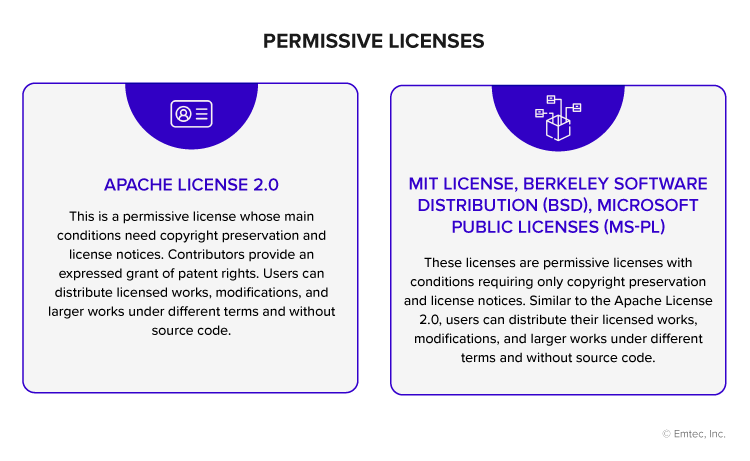10.26.21 By Sreenivas Vemulapalli

According to the 2019 Open Source Security (OSS) and Risk Analysis (OSSRA) Report, 96% of codebases contain open source components. With the average codebase containing 298 open source components, they account for 60-80% of all software code.
Engineers leverage these open source licenses and their components to help create, accelerate, and innovate their software development processes. For development teams that utilize open source and third-party code, understanding usage guidelines as well as following them is critical to maintaining quality and reducing risk.
For example, in the above report, it was also reported that 85% of codebases contained components that were more than four years out-of-date or had no development activity in the last two years. Such incidences pose a legal, financial, and security risk to organizations who utilize software with these components. While many organizations have dedicated Legal/Audit/Engineering/Management teams in place, it is the responsibility of the developer to understand and mitigate risks that come with OSS licenses as well as the guidelines for proper usage.

Today, engineers have a wide array of OSS licenses to choose from, which has given rise to the domination of permissive open source in comparison to copyleft licenses. The Apache 2.0 license and the MIT License are far more popular than the GPL family, together comprising over 50% of open source licenses currently in use.

Source: WhiteSource
License Preferences
Certain licenses are leveraged far more than others as they satisfy numerous requirements of both engineers and businesses too. Of course, specific license permissions and limitations determine license preference for many and hence, the MIT license is predominately preferred as per WhiteSource.

Source: WhiteSource
Now that we know the names, types, and categories of open source licenses, let’s deep dive into how to actually use them. With every type of OSS license, there are different permissions, conditions, limitations you need to follow. We have included the most commonly used and preferred OSS licenses below.



The above table highlights the multiple aspects you should consider before utilizing, sharing or distributing your work using OSS components. Be sure to also lean on the expertise of your legal, engineering, and management teams to guide you.
Opensource/ Third-party software Review Board (OSRB) is a team comprised of members responsible for establishing and reviewing licensing terms as well as reviewing against known security vulnerabilities before adopting new OS libraries/components. The OSRB also provides strategy, communication and guideline manuals (set of rules and regulations to be followed) for IT professionals in organizations. It also consists of the following aspects to regulate the use of OSS licenses-
Recommended Guidelines
Any open source component licensed under the following commonly-used licenses can be freely used without additional disclosure or approval by the OSRB.
Any other software other than those mentioned above will require review and explicit permission from OSRB.
Approval Process
Every organization has a predefined process to identify, review, leverage, manage, and distribute components associated with diverse open source licenses. With this process in place, organizations can identify risks and regulations associated with OSS licenses and also gain other benefits including accelerated delivery schedules and preemptive actions to mitigate risks or surplus costs.

Whether permissive or copyleft, all open source licenses have notice requirements. Typically, this means you need to include a copy of the applicable license when distributing open source software.
OSS licenses for Mobile Applications
Mobile applications are no exception to the above guidelines. According to a report by OpenLogic, 71% of apps using open source licenses were deemed non-compliant. Since mobile applications are installed on user devices, they fall under the “distributed” category and you are obligated to provide a copy of the license itself along with any notices or attributions required by the license. Below are examples of OSS licenses used by popular applications such as MS Outlook, Zillow, Facebook and Instagram respectively.


Follow the instructions below to include the licenses of the software used in your applications. If you are using components which don’t fall under the guidelines provided, contact the OSRB for further advise. Here are some helpful links to guidelines on how to use opensource licenses from Google, LinkedIn, Github etc.
OSS licenses for Web Applications
Web Applications render or deliver HTML, JavaScript, CSS & plugins to consumers which are executed in their browsers. You are obligated to keep and provide the attribution information for these libraries.
OSS licenses for Windows Applications
Web Services/ REST APIs
Other Internal Components
Applications or services that run on internal servers and are not distributed to end customers are mandated to provide attribution. However, there are some license types which require attribution. As a precaution, you should leave the license and copyright information of the libraries in the code.
OSS licenses for Stack Overflow
Stack overflow is one of the largest communities of developers who share their knowledge. However, the solutions or code snippets contributed by users on Stack Overflow are released under the Creative Commons Attribution-Share Alike 3.0 Unported (CC BY-SA 3.0) license which requires attribution to the source. Though we don’t encourage or support borrowing code from such sites, if it can’t be avoided you need to provide the right attribution to the source.
As per the CC BY-SA 3.0 license terms, you need to fulfill the following requirements.
It is recommended to add the following attribution when you are using code from Stack overflow.
// The class below was written by StackOverflow user user name and is licensed
// under CC BY-SA 3.0 ( http://creativecommons.org/licenses/by-sa/3.0/ ).
// http://stackoverflow.com/a/9999/99999
// https://stackoverflow.com/users/99999/username
OSS Licenses are significant and can pose significant risk to organizational operations and reputation.
If you need a partner to help analyze your requirements and identify the right opensource solutions and also ensure adherence to opensource and 3rd party licensing, we are here to help you. Our teams can help you analyze the right stack, identify licenses, get reports, understand and mitigate risks.
Contact our experts, today!
References
opensource.org/licenses
github.com/todogroup/policies/blob/master/linuxfoundation/lf_compliance_approval.pdf
www.slideshare.net/blackducksoftware/you-cant-live-without-open-source-results-from-the-open-source-360-survey
www.ibrahimatlinux.com/uploads/6/3/9/7/6397792/opensourcestrategyforum-haddad-1.0.pdf